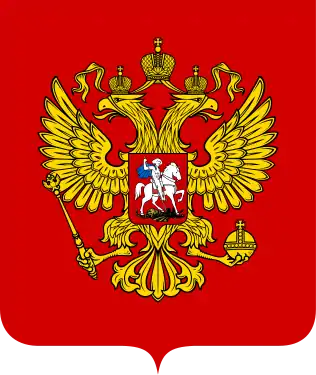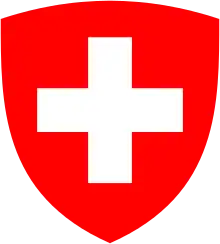Russia–Switzerland relations
Russia–Switzerland relations are foreign relations between Russia and Switzerland. Switzerland opened a consulate in Saint Petersburg in 1816, upgrading it to a legation 90 years later. The two countries broke off diplomatic relations in 1923, when Russia was going through a period of revolutionary turmoil – and they were not resumed until 1946.
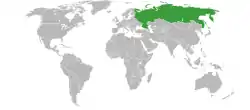 | |
Russia |
Switzerland |
|---|---|
History
Imperial Russia and Switzerland
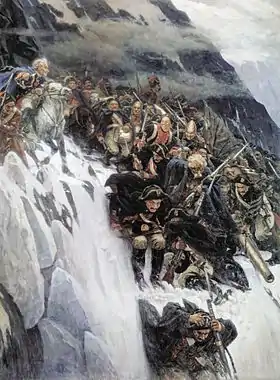
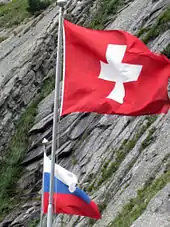
Contacts of some consequence between the Swiss and the Russians started as early as the 17th century, when a twenty-year-old Swiss soldier François (Franz) Lefort came to Moscow in 1675 to serve the Romanov Dynasty, and soon reached a position of prominence. Although Czar Peter I was crowned while still a child (1682), it was Peter's sister Sophia, and later his mother Nataliya Naryshkina, and their boyar relatives, who were running the country for over a decade after - leaving young Peter with plenty of time to dream of how to change his country when he has real power. Lefort happened to be one of the people who greatly influenced the young Czar's world view, and, once Peter became fully in charge of the country, the Swiss soldier became one of his top advisers and became highly influential during the first several years of Peter's modernization campaign.
Even though Lefort died fairly early in Peter's reign (1699), quite a few other Swiss soldiers, adventurers, educators, and scholars made a contribution in the history of Russian Empire. The Swiss-Italian architect Domenico Trezzini was the general manager of the construction of Saint Petersburg until 1712,[1] and is credited with the creation of Petrine Baroque, characteristic of that city's early architecture. The mathematician Leonhard Euler and five members of the Bernoulli family became members of the Saint Petersburg Academy of Science. A century after Lefort, Frédéric-César de La Harpe was influential in the upbringing of the future Czar Alexander I.
The first large-scale appearance of Russians in Switzerland dates to the early years of the Napoleonic Wars, when Suvorov's army fought back and forth across Switzerland and northern Italy in 1799–1800. While the results of these campaigns were inconclusive, they earned Suvorov the rank of Generalissimo, and became (in particular, the retreat over Panix Pass) a favorite topic for Russian painters.
To reciprocate, around 8,000 Swiss men joined Napoleon's army that invaded Russia in 1812. Only a few hundreds survived the disastrous campaign. The heroism of the Swiss at Berezina is immortalized in the Beresinalied.
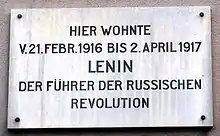
In the 19th century Switzerland became a popular refuge with Russian anti-Czar émigrés, due to its culture of freedom, absence of a particularly close relationship between the Swiss republican government and that of Imperial Russia, and on occasions, its neutrality in wars as well. The list of Russian exiles who found shelter in Switzerland runs from Alexander Herzen, who became Swiss citizen[1] in 1851, to Vladimir Lenin, who stayed in Switzerland during World War I, and was only able to leave the country in 1917 thanks to the so-called sealed train.[2][3]
The same reasons made the country a magnet for Russian students. The number of Russian students in Switzerland peaked in 1906–07, just after the defeat of the Russian Revolution in 1905, when 36% of all university students in Switzerland were Russians (2,322 out of the total of 6,444).[1] Not only the majority of all foreign students enrolled in Swiss universities that year (there were 3,784 of them[4]) had come from Russia, over two-thirds of these Russian students (1,507 of 2,322) were female mostly because of the Russian educational qualification for the Jewish population.[1][5]
Modern Russia and Switzerland
After the dissolution of the Soviet Union, the number of Russian visitors and migrants to Western Europe increased significantly, compared to the Soviet period. However, for most of them Switzerland remained somewhat of a flyover country on the way to the more popular Mediterranean destinations.[6]
The tranquility turned into tragedy on 1 July 2002, when a Bashkirian charter flight collided with a DHL cargo plane just before entering Swiss air space from Germany. All 71 people aboard the two aircraft died in the collision. Having lost his entire family, Vitaly Kaloyev killed the air traffic controller, Peter Nielsen, whom he deemed responsible for the accident.
Resident diplomatic missions
- Russia has an embassy in Bern and a consulate-general in Geneva.
- Switzerland has an embassy in Moscow and a consulate-general in Saint Petersburg.
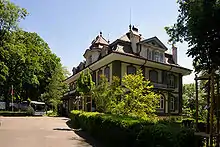 Embassy of Russia in Bern
Embassy of Russia in Bern Consulate-General of Russia in Geneva
Consulate-General of Russia in Geneva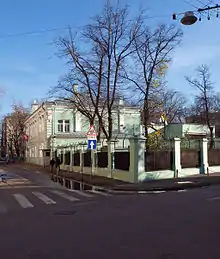 Embassy of Switzerland in Moscow
Embassy of Switzerland in Moscow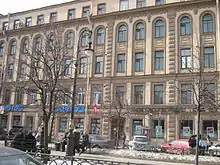 Consulate-General of Switzerland in Saint Petersburg
Consulate-General of Switzerland in Saint Petersburg
See also
Notes and references
- Russian Switzerland: Part 1
- Ted Widmer (20 April 2017). "Lenin and the Russian Spark". The New Yorker. Retrieved 26 November 2019.
- Joshua Hammer (2017). "Vladimir Lenin's Return Journey to Russia Changed the World Forever". Smithsonian. Retrieved 26 November 2019.
- Chisholm, Hugh, ed. (1911). . Encyclopædia Britannica. 26 (11th ed.). Cambridge University Press. pp. 244–245.
- http://www.yivoencyclopedia.org/article.aspx/Censorship/Censorship_in_the_Russian_Empire
- Switzerland is a party to IASTA, and generally allows overflight of its territory by other countries' civil aircraft. (International Air Services Transit Agreement - list of signatory states)
External links
| Wikimedia Commons has media related to Relations of Russia and Switzerland. |
